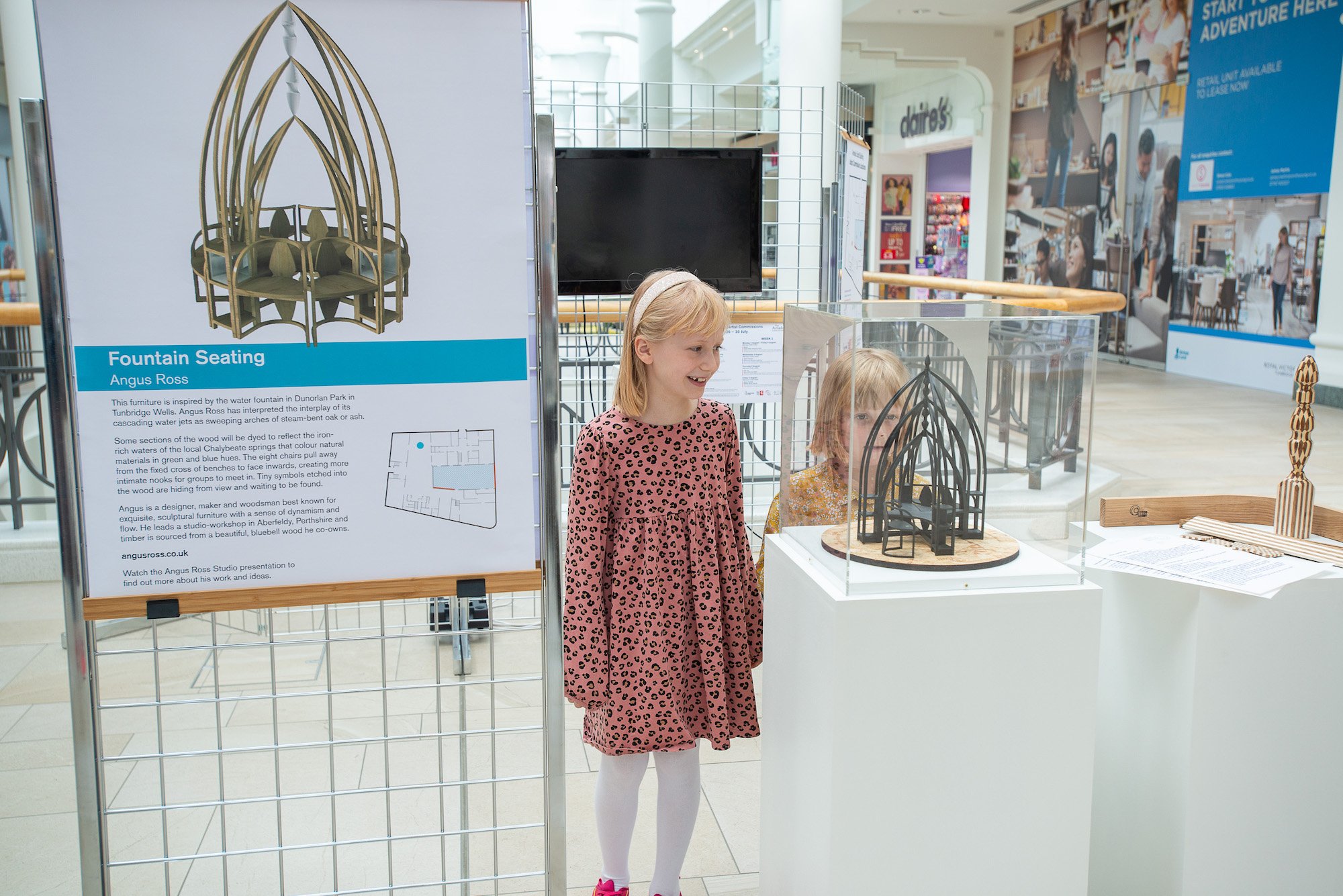Fountain Seating Commission
For The Amelia, Tunbridge Wells.
We love making for the public realm as they are often larger projects and designed to be used by a whole community for long periods of time. The Fountain Seating Commission for a new amenity building called The Amelia, Tunbridge Wells began during lockdown in January 2021 and the initial research was conducted on-line. This is very unusual, as Angus prefers to visit a place, and get a feel for the history, landscape and people before he starts designing. However pictures of the flowing water in the Georgian Dunorlan Fountain captured his imagination. A tall cascading form also felt appropriate for the location by a huge restored arched window. The intention was to draw people into the building, and stimulate interest in exploring the collections as it references Tunbridge ware. It also provides a flexible accessible place to gather and sit.
The light wood in the Fountain Seating is ash (representing water) and the darker horizontal surfaces and vitrines are fumed oak (representing soil).
The Amelia opened on 28th April 2022.
The Fountain Seating is made principally in oak and ash, with a turned central column of yew, walnut and sycamore. Tunbridge Ware is a woodwork tradition specific to Tunbridge Wells and is created by glueing blocks of different naturally coloured timber together to create a picture. This is then sliced into thin layers to create multiple pictures that were incorporated into homeware. The central column of the Fountain Seating is built up with blocks of wood in the same way, and the pattern in the centre of the central unit (below) is a slice of the column above.
Two techniques have been used for the curved wood in this installation: laminating and steam-bending. The tall arches are made by laminating ash. This involves cutting planks of ash lengthwise into thinner slices, and reassembling with glue between each layer and then pressing the layers over a curved former (the layers can slide as required to take up the shape).
Once dried, laminating creates precise, strong curved shapes. In the finished piece you need to look very closely at the arches to see the layers of wood.
The second technique to create curves is steam-bending - an exciting, fast, physical and unpredictable process and our signature technique. Lengths of wood are steamed to soften the lignum (glue) between the wood fibres and whilst the plank is steaming hot and malleable we have a few minutes to bend it into the desired form over special jigs.
The chairs have a very complex steam-bend as one length of wood flows up one front leg, round the back-rest and down the other front leg. This creates the structure of the chair. We had to do a lot of experimentation with this new bending jig to have success, and it requires four makers, working in unison, to achieve the bend.
The steam-bent components are then left to dry, in a drying-jig for a few weeks.
The backrest is also steambent and dried over a jigs.
The bent wood-fibres can be clearly seen in flowing forms of ash. The horizontal surfaces of the chair and central installation are a contrasting colour and techniques and dark fumed oak.
In the summer of 2021 there was a week of public engagement to generate excitement and engage people with the new public art commissions for the Amelia. We asked people (mostly children) to draw something they would like hidden within the installation and this brought an interesting new dimension to the Fountain Seating project.
The children’s drawings were overwhelmingly of ‘nature’ and most were specifically of animals, insects, or plants, with a particular interest in ‘mini-beasts’. This reminds us that children are fascinated by details of nature - that adults may have stopped noticing or take for granted. Tunbridge Wells is located in The ‘Weald’ (meaning woodland in Old English). The original woodland is lost and ash is now the most common tree in Kent currently being devastated by Ash Dieback Disease and there is great concern that we are also losing the insect populations dependent on ash trees as these insects are crucial for pollination, and provide food for birds and mammals.
Photo by David Hodgkinson.
The children’s drawings led us to Dr Ian Beavis, Research Curator at Tunbridge Wells Museum, and an expert in the local natural history of the Weald. He helped us to identify the insects, plants and animals associated with oak and ash in The Weald. We then selected a few species that resonated with the children’s drawings, and commissioned local artist, Rachel Backshall to create illustrations that could be laser-etched onto the installation.
We intended to show true to life wildlife illustrations of an appropriate size, and some were startling, for example the enormous Privet Hawk Moth above or the tiny oak-mining bee (Andrena ferox) which feeds almost exclusively on oak pollen and is considered threatened and requiring protection. Over fifty illustrations can be found hidden in the Fountain Seating installation. Some are very obvious and others tiny and require careful looking such as wood-ants the fumed oak in the central section.
As Ash Dieback continues to devastate ash trees in The Weald it seems likely that some of the species etched onto the Fountain Seating, will be lost within the life-time of the installation. Our hope is that recording current bio-diversity, and increasing awareness and interest in local wildlife, supports the museum’s intension to inspire and educate people about their local area. It may even encourage people to take small steps to support local wildlife, for example, by planting bee friendly flowers and tolerating weeds in our gardens and public spaces. Small steps taken by large numbers of people do have a positive effect. Sadly it has been estimated that up to 95% of ash trees will be lost in the next twenty years but there are various research projects underway nationally to identify resilient trees and make long-term plans for reintroduction with resilient trees.
“We wanted to thank you for your hard work and dedication creating Fountain Seating for the Welcome Hall.
Everyone who has encountered it has been struck by its design, quality of making and attention to detail. It has been fully adopted by visitors already, who are intuitively understanding how to use it, setting themselves up in little groups of conversation as they take in everything else around them.”













